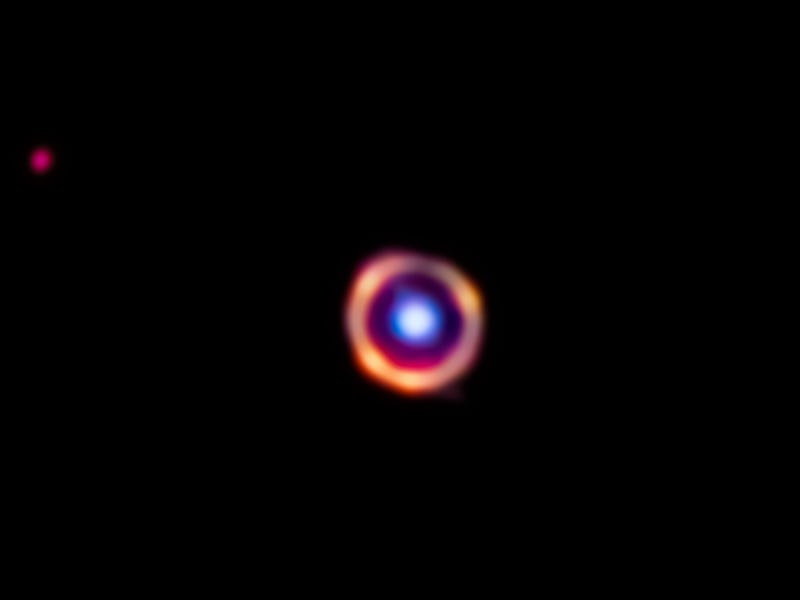Strange Phenomenon Predicted by Einstein Reveals Oldest Evidence of Mysterious Space Dust
Astronomers paired a telescope with a gravitational distortion to discover the oldest-known instance of a peculiar substance.

The James Webb Space Telescope (JWST) is just one month away from celebrating its first official year in operation. And so far, it’s seen a lot. But as it continues to peer deeper into cosmic history, where light’s finite speed reveals what the universe looked like billions of years ago, things get wonky.
In a new paper published Monday in Nature, astronomers using the telescope found the oldest-known instance of a molecule that’s crucial to star formation. It’s called a polycyclic aromatic hydrocarbon (PAS), and its presence is still a puzzle. But this recent discovery within a galaxy that existed just 1.5 billion years after the Big Bang could challenge our current understanding of when the first star formed.
The molecule, known as PAS, in big clumps, is sooty and carcinogenic. As JWST operations program scientist Jane Rigby told an audience at the 242nd Meeting of the American Astronomical Society in New Mexico on Monday, it's not something you want to have up your nose.
Astronomers know that the presence of PAS is typically involved in the process through which gas and dust condense to form stars, but they aren’t entirely sure of all the mechanisms involved.
The world was really different in the distant universe, says Justin Spilker, the paper’s lead researcher and assistant professor of astronomy at Texas A&M University. After the Big Bang, “the universe is almost entirely hydrogen and helium… and yet somehow, you have to form a first generation of stars,” Spilker tells Inverse.
Some astronomers think that when the universe was that young — just 10 percent of its current age — it was so much warmer and smaller that massive galaxies may have been able to form stars hundreds of times faster than the Milky Way does today. Still, they don’t entirely know how it happened.
To view the ancient galaxy, astronomers peered at an Einstein ring. This phenomenon occurs when you can almost draw a straight line between Earth, the distant galaxy, and a closer galaxy in the middle. The central object has so much gravity that it warps the light of the galaxy farther away. This allowed a team, who published their new findings on Monday in the journal Nature, to discover the oldest-known instance of a peculiar molecule.
How astronomers used a “cosmic telescope” to find PAS
To spot this crucial dust, astronomers used the help of a telescope nature created itself. They pointed the JWST at a celestial donut called an Einstein ring, created when a heavy object, like a galaxy or cluster, bends and magnifies the light of an object much farther away. This allows for a higher resolution of this far-flung light.
The result was wonky but incredibly useful. Within this circular band, further enhanced by the JWST, was clear evidence of PAS.
“This is the furthest back in time we’ve even been able to see organic molecules in the universe,” Rigby said on Monday. She’s principal investigator of the TEMPLATES program (short for Targeting Extremely Magnified Panchromatic Lensed Arcs and Their Extended Star Formation) through which Spilker’s team viewed the gravitationally-lensed galaxy.
The ring is light from galaxy SPT0418-47, which existed only 1.5 billion years after the Big Bang. The sphere is a galaxy closer to Earth, whose gravity has bent the light behind it, magnifying SPT0418-47 and what is present in this much older galaxy. Astronomers used the James Webb Space Telescope to look at this object, and within SPT0418-47 they found the oldest instance of a particular sooty molecule usually associated with star formation.
Could this shift our understanding of when stars formed?
Astronomers don’t know why these molecules actually exist in the early universe.
“They are basically the biggest molecules in space that we can actually find,” Spilker says. It’s likely that PAS are too complex to form alone in the void of space.
One theory is that they come from aging stars. “When stars die, they start to poof up and get really, really fluffy, and then their outermost layers are barely held on by gravity. So those outer layers just start to float away and cool down as they move further away. And we think that’s where a lot of these rich kinds of molecules are forming,” Spilker says.
When a dying star sheds its outermost layers, it creates displays like this beautiful object, called planetary nebulas. This is a Hubble Space Telescope image of NGC 6302, more popularly called the Bug Nebula or the Butterfly Nebula.
If that’s the case, PAS could hint that the galaxy from 1.5 billion years after the Big Bang — which is already ancient at roughly 10 percent of the universe’s current age – started forming stars much earlier than astronomers can currently see.
“It’s had time to get to the point where those stars could be born, could live, could die and start poofing out their outer layers and making these big complex molecules,” Spilker says.
The next course of action is to build context for PAS and gain “some constraints on what is physically going on in these galaxies, what processes are in place, that are leading to this emission,” Anthony Gonzalez, the study’s co-author and an astronomy professor at the University of Florida, tells Inverse.
One thing is for sure, though: None of this would have been possible without the new JWST. “Having [the JWST] has really been the first time that we have been able to get at this question. Our previous versions of telescopes were just so much smaller and so much less sensitive that we couldn’t really have a good idea of whether these molecules existed or not,” Spilker says.
JWST will celebrate the one-year anniversary of its first official science release on July 11. Its best work, it seems, is yet to come.
This article was originally published on